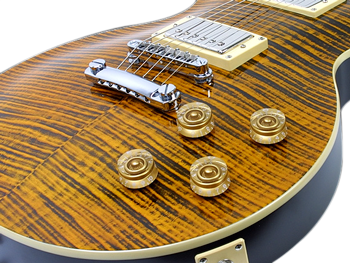
How to change the strings on your Les Paul or Tune-o-Matic style bridge
Contents
A lot of times Les Paul guitars can go out of tune because of string slippage or even just bad strings. I like to change my strings once every other week on the Les Pauls that I play. This keeps the strings alive and full of bounce. The only thing worse than dead strings is string buzz. Unlike some guitars, the Les Paul or Tune-o-matic styled bridge is pretty easy to change strings. Let’s get started.
Removing the old strings
First, we need to remove the old strings. I usually just down tune the strings until they are floppy. When you are dropping the string tension, pay close attention to the bridge. Most Les Paul tailpieces are not physically attached to the bridge. They are just held in place by the string tension. After the tension is gone, the tailpiece will fall right out. Wiggle the tailpiece to see if it is loose. If it is firm in the bridge posts, you can go ahead and take the strings out of the tuner posts. After you pull the strings out of the tuners, you can take the tailpiece right off the guitar. It should just slide right out. Don’t leave it in the bridge posts because it could fall out and dent your guitar’s body.
Clean the Fretboard
Whenever I change the strings on any of my guitars or my customers guitars, I always clean the fretboard. Most electric guitar fretboards are unfinished–meaning there is no lacquer sprayed on the fretboard itself. Among these unfinished fretboards, ebony and rosewood fretboards are the most common. You can use any number of special fretboard cleaning products to clean your fretboard, but I like to use Murphy’s Oil Soap. Oil soap not only helps clean your fretboard, it also helps condition and moisturize it. Since your fretboard is unfinished, there is no layer of lacquer to help protect it from the elements. The fretboard can dry out and even crack if it is severely dried out. Oil soap will prevent your fretboard from drying out. It will also give your fretboard a new clean shine.
To clean your fretboard, simply drip a small amount of oil soap on your fretboard. It doesn’t take much–a little goes a long way. Then take some #0000 steel wool and rub the oil soap into the fretboard and remove the dirt buildup. You may want to cover your pickups, so that pieces of the steel wool do not get magnetically stuck to the pole pieces. I like to polish the frets at the same time. While the steel wool is soaked in the oil soap, you can rub and polish the frets with the steel wool until the frets are shiny and clean. After the fretboard and frets are cleaned, you can wipe away the excess oil soap with a piece of paper towel. Now your fretboard is clean and conditioned and your frets are nice and shiny. Here’s some info about how to clean a finished fretboard.
Restringing your Les Paul
After the fretboard is cleaned, I like to start restringing the guitar by stringing one or two strings through the tailpiece and placing the tailpiece back in the bridge posts. Make sure the tailpiece is secure before you let go of it. Since most guitars go out of tune because the strings slip out of place in the tuner, it is important to wrap the string around the tuning post enough times to prevent it from slipping. The magic number of wraps is three. Any more wraps than three is kind of redundant. Plus, it makes it a pain to take the string off the next time you restring your guitar.
First, I line up all of the tuning postholes, so the holes are open toward the nut. This way the string can go straight through the tuning post. Now you want enough slack in the string to wrap it around the post approximately three times. This keeps the string from slipping when the guitar is tuned. You don’t always have to have a full three wraps, but it is a good general rule of thumb. The string posts themselves can be used to measure the ideal amount of string slack. Pull the sixth string through the post until it’s tight. The sixth string is the ideal length at the fifth string’s tuning post. Grip the string at the fifth string’s post and slide the string back through the sixth string’s post until your fingers hit the sixth string tuning post. Now bend the string in a 90-degree angle. This bend will help keep the string from pulling out of the tuner while you are tightening the tension. Next, pull up on the string to maintain tension on it while you are turning the tuning button with your string winder. Make sure each new wrap of the string is below or underneath the previous wrap. Wrapping the strings like this prevents the strings from slipping when you bring it up to pitch. The tapered tuning post squeezes the string in the post’s hole by forcing the wrapped strings toward the center of the post.You can use this process for each string.
I like to get all the strings on the guitar before I bring it completely up to pitch. I usually slightly tighten each string then move on to the next one. After all the strings are on the guitar, I bring them up to pitch.
Stretching the strings
Whenever you change the strings on your guitar, it is important to stretch the new strings. Stretching your strings will help keep them in tune better later on. Once the guitar is in tune, I like to place my thumb flat on the top of the string and my fingers on the bottom of the string–kind of like playing fingerstyle. Then I just push down with my thumb and up with my fingers. I like to start at the bridge and bend the string a few times going down the neck. It’s important to do this to all the strings. Stretching the string will intially make your guitar go out of tune, so you’ll have to retune it one more time.
Ready to play
Now your Les Paul is all set to play. Plug it into your amp and crank it up!


thanks very much